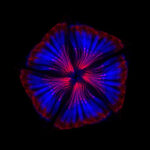German cockroaches are a notorious household pest, scurrying across countertops and cabinets, often prompting a shiver of disgust. One common question that arises when facing these unwelcome guests is: Can A German Roach Fly? Understanding their capabilities, or lack thereof, is crucial for effective pest control. This article delves into the flight abilities of German cockroaches, separating fact from fiction and providing valuable insights into their behavior and how to manage infestations.
While it might seem like a simple question, the answer is more nuanced than a straightforward yes or no. Adult German cockroaches do indeed possess wings. If you observe one closely, you’ll notice they have two sets of wings that lie flat on their back. The outer wings, known as tegmina, are leathery and protect the more delicate hind wings used for flight in other insects. However, despite being equipped with wings, German cockroaches are not strong fliers and rarely take to the skies. They are far more inclined to run, scuttle, and climb.
Why German Roaches Prefer Scampering to Soaring
Several factors contribute to the German cockroach’s aversion to flight. Their bodies are not aerodynamically designed for efficient flight. Unlike insects like flies or mosquitoes, German cockroaches have a relatively broad, flattened body shape that isn’t conducive to agile aerial maneuvers. Their legs are built for speed and agility on surfaces, allowing them to quickly navigate complex environments and escape predators or reach food sources. This terrestrial locomotion is their primary mode of transportation.
Furthermore, German cockroaches thrive in environments that are typically cluttered and close to the ground, such as kitchens, bathrooms, and pantries. Their survival strategy relies on seeking refuge in cracks, crevices, and dark spaces. Flying would expose them to predators and the open, unfamiliar spaces they generally avoid. Their instinct is to stay low and hidden, making crawling a much more practical and safer mode of movement for their lifestyle.
When Might a German Roach Attempt Flight?
Although rare, there are instances where a German cockroach might attempt to fly or, more accurately, glide. If a German cockroach is startled or feels threatened, it might flutter its wings in an attempt to escape. Similarly, if they are on a high surface, they might use their wings to glide downwards rather than jumping, offering a degree of controlled descent. However, these instances are not true powered flight. It’s more of a clumsy, uncontrolled flutter for short distances.
Another potential scenario is during periods of extreme stress or overcrowding. In severe infestations, competition for resources like food and shelter can become intense. In such situations, some cockroaches, particularly males who are more mobile, might attempt short flights in search of new territories or resources. However, even in these circumstances, flight is not their preferred method of movement.
The Importance of Understanding Roach Flight (or Lack Thereof) for Pest Control
Knowing that German cockroaches are not proficient fliers is important for effective pest control strategies. Instead of focusing on aerial treatments, pest control efforts should concentrate on ground-level solutions. This includes:
- Sealing entry points: Since they prefer crawling, sealing cracks and crevices in walls, floors, and around pipes becomes paramount to prevent their entry.
- Focusing on harborage areas: Targeting treatment in kitchens, bathrooms, and other areas where they are known to harbor is more effective than general fogging or spraying in open air.
- Using baits and traps: These methods are highly effective as they capitalize on the cockroach’s natural foraging behavior on the ground, attracting them to poisoned food or sticky surfaces.
- Maintaining sanitation: Eliminating food and water sources at ground level is crucial. Regular cleaning, proper food storage, and fixing leaks will make the environment less hospitable to these crawling pests.
Beyond Flight: Other Key German Cockroach Habits and Dangers
While their limited flight ability is interesting, it’s crucial to remember other aspects of German cockroach behavior and the dangers they pose:
- Rapid Reproduction: German cockroaches are prolific breeders. Females can produce egg capsules every few weeks, each containing dozens of eggs. This rapid reproductive rate contributes to quick infestation growth.
- Disease Vectors: They are known to carry and spread numerous pathogens, including bacteria, parasites, and allergens. They pick up germs in unsanitary places and transfer them to food preparation surfaces, posing health risks.
- Allergens and Asthma: Cockroach allergens are a significant trigger for asthma and allergies, particularly in children. Their droppings, shed skins, and dead bodies contribute to these allergens in homes.
- Resilience: German cockroaches are remarkably resilient and adaptable. They can survive in various environments and develop resistance to certain insecticides, making control challenging.
Conclusion: Grounded Pests, Grounded Solutions
In conclusion, while German cockroaches possess wings, they are not adept fliers and overwhelmingly prefer to crawl. Their body structure, habitat preferences, and survival strategies are all geared towards terrestrial movement. Understanding this, along with their other habits and the dangers they present, allows for more targeted and effective pest control measures. Focusing on sanitation, sealing entry points, and utilizing ground-based treatments like baits and traps will be far more successful in managing German cockroach infestations than worrying about aerial assaults. If you are struggling with a German cockroach problem, consulting a pest control professional is always recommended for a comprehensive and effective solution.

